List of uncrewed NASA missions
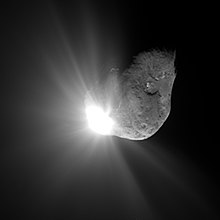
Following is a sampling of some of NASA's past and present programs excluding manned spacecraft. The years in brackets are for first and latest launching. A program is a number of flights or missions with the same kind of satellite, therefore the name of the program and the name of the satellite used will often be the same. In all NASA have made more than 1,000 unmanned missions into Earth orbit or beyond.[1]
List of programs
Explorer program (1958–)

The Explorer program continues and over more than five decades has launched 90+ missions into Space. It has matured into one of NASA's lower-cost mission programs, relative to its other programs.
It began as a U.S. Army proposal to place a scientific satellite into orbit during the International Geophysical Year (1957–58); however, that proposal was rejected in favor of the U.S. Navy's Project Vanguard. The Explorer program was later reestablished to catch up with the Soviet Union after that nation's launch of Sputnik 1 on October, 1957. Explorer 1 was launched January 31, 1958; at this time the project still belonged to ABMA and JPL.[2] Besides being the first U.S. satellite, it is known for discovering the Van Allen radiation belt.
The Explorer program was transferred to NASA, which continued to use the name for an ongoing series of relatively small space missions, typically an artificial satellite with a science focus. Over the years, NASA has launched a series of Explorer spacecraft carrying a wide variety of scientific investigations.
Pioneer program (1958–1978)
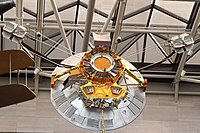
The Pioneer program is a series of NASA unmanned space missions that was designed for planetary exploration. There were a number of such missions in the program, but the most notable were Pioneer 10 and Pioneer 11, which explored the outer planets and left the solar system. Both carry a golden plaque, depicting a man and a woman and information about the origin and the creators of the probes, should any extraterrestrials find them someday.
Additionally, the Pioneer mission to Venus consisted of two components, launched separately. Pioneer Venus 1 or Pioneer Venus Orbiter was launched in 1978 and studied the planet for more than a decade after orbital insertion in 1978. Pioneer Venus 2 or Pioneer Venus Multiprobe sent four small probes into the Venusian atmosphere.
Echo Project (1960–1964)
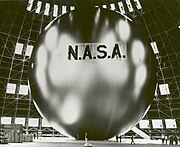
Project Echo was the first passive communications satellite experiment. Each spacecraft was a metalized balloon satellite to be inflated in space and acting as a passive reflector of microwave signals. Communication signals were bounced off of them from one-point on Earth to another.[3] NASA's Echo 1 satellite was built by Gilmore Schjeldahl Company in Northfield, Minnesota. Following the failure of the Delta rocket carrying Echo 1 on May 13, 1960, Echo 1A was put successfully into a 944 to 1,048 mi orbit by another Thor-Delta[4][5] and a microwave transmission from the Jet Propulsion Laboratory in Pasadena, California was received at Bell Laboratories in Holmdel, New Jersey on August 12, 1960.
Echo 2 was a 41.1-meter (135 ft) diameter metalized PET film balloon, which was the last balloon satellite launched by Project Echo. It used an improved inflation system to improve the balloon's smoothness and sphericity. It was launched January 25, 1964 on a Thor Agena rocket.
Ranger program (1961–1965)
The Ranger program was a series of unmanned space missions by the United States in the 1960s whose objective was to obtain the first close-up images of the surface of the Moon. The Ranger spacecraft were designed to take images of the lunar surface, returning those images until they were destroyed upon impact. A series of mishaps, however, led to the failure of the first six flights. At one point, the program was called "shoot and hope".[6] Congress launched an investigation into “problems of management” at NASA Headquarters and Jet Propulsion Laboratory.[7] After reorganizing the organization twice, Ranger 7 successfully returned images in July 1964, followed by two more successful missions.
Ranger was originally designed, beginning in 1959, in three distinct phases, called "blocks". Each block had different mission objectives and progressively more advanced system design. The JPL mission designers planned multiple launches in each block, to maximize the engineering experience and scientific value of the mission and to assure at least one successful flight. Total research, development, launch, and support costs for the Ranger series of spacecraft (Rangers 1 through 9) was approximately $170 million.
Telstar (1962–1963, commercial project with NASA contribution)

Telstar was not a NASA program but a commercial communication satellite project. NASA's contribution to it was limited to launch services, as well as tracking and telemetry duties. The first two Telstar satellites were experimental and nearly identical. Telstar 1 was launched on top of a Thor-Delta rocket on July 10, 1962. It successfully relayed through space the first television pictures, telephone calls, fax images and provided the first live transatlantic television feed. Telstar 2 was launched May 7, 1963.[8]
Bell Telephone Laboratories designed and built the Telstar satellite. They were prototypes intended to prove various concepts behind the large constellation of orbiting satellites. The faceted 171 lb (77 kg) sphere had a diameter of a little more than 34 inches (about 1 m). Bell Telephone Laboratories also developed much of the technology required for satellite communication, including transistors, solar cells, and traveling wave tube amplifiers. To handle Telstar communications, AT&T built ground stations at Andover, Maine; Pleumeur-Bodou, France; and Goonhilly Downs, Britain. These were similar to, but larger than, the ground station used for project Echo.[8]
Telstar was a technical success. A US. Information Agency (USIA) poll showed that Telstar was better known in Great Britain than Sputnik had been in 1957. In contrast to Sputnik, Telstar's signals were useful.[8]
Mariner program (1963–1973)

The Mariner program conducted by NASA launched a series of robotic interplanetary probes designed to investigate Mars, Venus and Mercury. The program included a number of firsts, including the first planetary flyby, the first pictures from another planet, the first planetary orbiter, and the first gravity assist maneuver.
Of the ten vehicles in the Mariner series, seven were successful and three were lost. The planned Mariner 11 and Mariner 12 vehicles evolved into Voyager 1 and Voyager 2 of the Voyager program, while the Viking 1 and Viking 2 Mars orbiters were enlarged versions of the Mariner 9 spacecraft. Other Mariner-based spacecraft, launched since Voyager, included the Magellan probe to Venus, and the Galileo probe to Jupiter. A second-generation Mariner spacecraft, called the Mariner Mark II series, eventually evolved into the Cassini–Huygens probe, now in orbit around Saturn.
All Mariner spacecraft were based on a hexagonal or octagonal "bus", which housed all of the electronics, and to which all components were attached, such as antennae, cameras, propulsion, and power sources. All probes except Mariner 1, Mariner 2 and Mariner 5 had TV cameras. The first five Mariners were launched on Atlas-Agena rockets, while the last five used the Atlas-Centaur. All Mariner-based probes after Mariner 10 used the Titan IIIE, Titan IV unmanned rockets or the Space Shuttle with a solid-fueled Inertial Upper Stage and multiple planetary flybys.
Lunar Orbiter program (1966-1967)

The Lunar Orbiter program was a series of five unmanned lunar orbiter missions launched by the United States from 1966 through 1967. Intended to help select Apollo landing sites by mapping the Moon's surface,[9] they provided the first photographs from lunar orbit.
All five missions were successful, and 99% of the Moon was mapped from photographs taken with a resolution of 60 meters (200 ft) or better. The first three missions were dedicated to imaging 20 potential manned lunar landing sites, selected based on Earth-based observations. These were flown at low inclination orbits. The fourth and fifth missions were devoted to broader scientific objectives and were flown in high-altitude polar orbits. All Lunar Orbiter craft were launched by an Atlas-Agena D launch vehicle.
During the Lunar Orbiter missions, the first pictures of Earth as a whole were taken, beginning with Earth-rise over the lunar surface by Lunar Orbiter 1 in August, 1966. The first full picture of the whole Earth was taken by Lunar Orbiter 5 on 8 August 1967.[10] A second photo of the whole Earth was taken by Lunar Orbiter 5 on 10 November 1967.
Surveyor program (1966–1968)
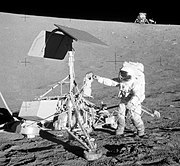
The Surveyor Program was a NASA program that, from 1966 through 1968, sent seven robotic spacecraft to the surface of the Moon. Its primary goal was to demonstrate the feasibility of soft landings on the Moon. The mission called for the craft to travel directly to the Moon on an impact trajectory (no orbit first), on a journey that lasted 63 to 65 hours, and ended with a deceleration of just over three minutes to a soft-landing. The program was implemented by NASA's Jet Propulsion Laboratory (JPL) to prepare for the Apollo program. The total cost of the Surveyor program was officially $469 million.
Five of the Surveyor craft successfully soft-landed on the Moon, including the first one. Two failed: Surveyor 2 crashed at high velocity after a failed mid-course correction, and Surveyor 4 was lost for contact (possibly exploding) 2.5 minutes before its scheduled touch-down.
All seven spacecraft are still on the Moon; none of the missions included returning them to Earth. Some parts of Surveyor 3 were returned to Earth by the crew of Apollo 12, which landed near it in 1969. The camera from this craft is on display at the National Air and Space Museum in Washington, DC.
Helios probes (1974–1976)
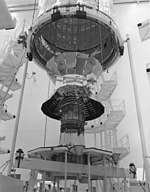
The Helios I and Helios II space probes, also known as Helios-A and Helios-B, were a pair of probes launched into heliocentric orbit for the purpose of studying solar processes. A joint venture of the Federal Republic of Germany (West Germany) and NASA, the probes were launched from Cape Canaveral Air Force Station, Florida, on Dec 10, 1974, and Jan 15, 1976, respectively. The probes are notable for setting a maximum speed record among spacecraft at 252,792 kilometres (157,078 mi)/h (157,078 mi/h or 43.63 mi/s or 70.22 kilometres (43.63 mi)/s or 0.000234c). The Helios space probes completed their primary missions by the early 1980s, but they continued to send data up to 1985. The probes are no longer functional but still remain in their elliptical orbit around the Sun.
Viking program (1975)

The Viking program consisted of a pair of American space probes sent to Mars—Viking 1 and Viking 2. Each vehicle was composed of two main parts, an orbiter designed to photograph the surface of Mars from orbit, and a lander designed to study the planet from the surface. The orbiters also served as communication relays for the landers once they touched down. Viking 1 was launched on August 20, 1975, and the second craft, Viking 2, was launched on September 9, 1975, both riding atop Titan III-E rockets with Centaur upper stages. By discovering many geological forms that are typically formed from large amounts of water, the Viking program caused a revolution in scientific ideas about water on Mars.
The primary objectives of the Viking orbiters were to transport the landers to Mars, perform reconnaissance to locate and certify landing sites, act as communications relays for the landers, and to perform their own scientific investigations. The orbiter, based on the earlier Mariner 9 spacecraft, was an octagon approximately 2.5 m (8.2 ft) across. The total launch mass was 2,328 kilograms (5,132 lb), of which 1,445 kilograms (3,186 lb) were propellant and attitude control gas.
Voyager program (1977)

The Voyager program is a series of NASA unmanned space missions that consists of a pair of unmanned scientific probes, Voyager 1 and Voyager 2. They were launched in 1977 to take advantage of a favorable planetary alignment of the late 1970s. Although they were officially designated to study just Jupiter and Saturn, the two probes were able to continue their mission into the outer Solar System. Both probes have achieved escape velocity from the Solar System and will never return. Both missions have gathered large amounts of data about the gas giants of the solar system, of which little was previously known.
As of November 12, 2010[update], Voyager 1 was at a distance of 115.251 AU (17.242 billion km, or 10.712 billion miles), traveling away from both the Earth and the Sun at a speed of 17 kilometres (11 mi)/s, which corresponds to a greater specific orbital energy than any other probe.[11]
High Energy Astronomy Observatory 1 (1977)

The first of NASA's three High Energy Astronomy Observatories, HEAO 1, launched August 12, 1977 aboard an Atlas rocket with a Centaur upper stage, operated until January 9, 1979. During that time, it scanned the X-ray sky almost three times over 0.2 keV – 10 MeV, provided nearly constant monitoring of X-ray sources near the ecliptic poles, as well as more detailed studies of a number of objects through pointed observations.
HEAO included four large X-ray and gamma-ray astronomy instruments, known as A1, A2, A3, and A4, respectively (before launch, HEAO 1 was known as HEAO A). The orbital inclination was about 22.7 degrees. HEAO 1 re-entered the Earth's atmosphere on March 15, 1979.
Solar Maximum Mission (1980)
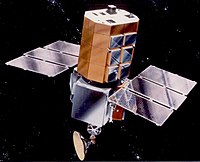
The Solar Maximum Mission satellite (or SolarMax) was designed to investigate solar phenomenon, particularly solar flares. It was launched on February 14, 1980.
Although not unique in this endeavor, the SMM was notable in that its useful life compared with similar spacecraft was significantly increased by the direct intervention of a manned space mission. During STS-41-C in 1984, the Space Shuttle Challenger intercepted the SMM, maneuvering it into the shuttle's payload bay for maintenance and repairs. SMM had been fitted with a shuttle "grapple fixture" so that the shuttle's robot arm could grab it for repair. The mission was depicted in the 1985 IMAX movie The Dream Is Alive.
The Solar Maximum Mission ended on December 2, 1989, when the spacecraft re-entered the atmosphere and burned up.
Infrared Astronomical Satellite, IRAS (1983)
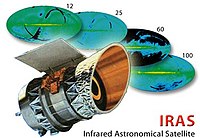
The Infrared Astronomical Satellite (IRAS) was the first-ever space-based observatory to perform a survey of the entire sky at infrared wavelengths.[12] It discovered about 350,000 sources, many of which are still awaiting identification. New discoveries included a dust disk around Vega and the first images of the Milky Way Galaxy's core.
IRAS's life, like that of most of infrared satellites that followed after, was limited by its cooling system. To effectively work in the infrared domain, the telescope must be cooled to cryogenic temperatures. In IRAS's case, 73 kilograms of superfluid helium kept the telescope at a temperature of 2 kelvins (about −271 °C) by evaporation. The supply of liquid helium was depleted after 10 months on November 22, 1983, causing the telescope temperature to rise and preventing further observations. The spacecraft continues to orbit close to the Earth.
The telescope was a joint project of the United States (NASA), the Netherlands (NIVR), and the United Kingdom (SERC). Over 250,000 infrared sources were observed at 12, 25, 60, and 100 micrometer wavelengths.[13]
Magellan probe (1989)

The Magellan spacecraft was a space probe sent to the planet Venus, the first unmanned interplanetary spacecraft to be launched by NASA since its successful Pioneer Orbiter, also to Venus, in 1978. It was also the first of three deep-space probes to be launched on the Space Shuttle, and the first spacecraft to employ aerobraking techniques to lower its orbit.
Magellan created the first (and currently the best) high resolution mapping of the planet's surface features. Prior Venus missions had created low resolution radar globes of general, continent-sized formations. Magellan, performed detailed imaging and analysis of craters, hills, ridges, and other geologic formations, to a degree comparable to the visible-light photographic mapping of other planets.
Galileo probe (1989)

Galileo was an unmanned spacecraft sent by NASA to study the planet Jupiter and its moons. It was launched on October 18, 1989 by the Space Shuttle Atlantis on the STS-34 mission. It arrived at Jupiter on December 7, 1995, a little more than six years later, via gravitational assist flybys of Venus and Earth.
Despite antenna problems, Galileo conducted the first asteroid flyby, discovered the first asteroid moon, was the first spacecraft to orbit Jupiter, and launched the first probe into Jupiter's atmosphere. Galileo's prime mission was a two-year study of the Jovian system. The spacecraft traveled around Jupiter in elongated ellipses, each orbit lasting about two months. The differing distances from Jupiter afforded by these orbits allowed Galileo to sample different parts of the planet's extensive magnetosphere. The orbits were designed for close up flybys of Jupiter's largest moons. Once Galileo's prime mission was concluded, an extended mission followed starting on December 7, 1997; the spacecraft made a number of daring close flybys of Jupiter's moons Europa and Io. The closest approach was 180 kilometres (110 mi) (112 mi) on October 15, 2001.
On September 21, 2003, after 14 years in space and eight years of service in the Jovian system (around Jupiter), Galileo's mission was terminated by sending the orbiter into Jupiter's atmosphere at a speed of nearly 50 kilometers per second. The program's funding was running out and the spacecraft was low on propellant; in addition, many systems were damaged. One of the reasons given for its destruction was to avoid the chance of it contaminating local moons with bacteria from Earth. Of particular interest was the ice-crusted moon Europa, which, thanks to Galileo, scientists now suspect harbors a salt water ocean beneath its surface.
Hubble Space Telescope (1990)

The Hubble Space Telescope (HST) is a space telescope that was carried into orbit by a Space Shuttle in April 1990. It is named after American astronomer Edwin Hubble. Although not the first space telescope, Hubble is one of the largest and most versatile, and is well known as both a vital research tool and a public relations boon for astronomy. The HST is a collaboration between NASA and the European Space Agency, and is one of NASA's Great Observatories, along with the Compton Gamma Ray Observatory, the Chandra X-ray Observatory, and the Spitzer Space Telescope.[14] The HST's success has paved the way for greater collaboration between the agencies.
The HST was created with a relatively small budget of $2 billion[15] and has continued operation since 1990, delighting both scientists and the public. Some of its images, such as the groundbreaking Hubble Deep Field, have become famous.
Ulysses (1990)
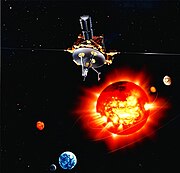
Ulysses is a decommissioned robotic space probe that was designed to study the Sun as a joint venture of NASA and the European Space Agency (ESA). Due to the loss of Challenger, the launch of Ulysses was delayed until October 6, 1990 aboard Discovery (mission STS-41). The spacecraft's mission was to study the Sun at all latitudes. To do this required a major orbital plane shift. Due to velocity change limitations of the Shuttle and the Inertial Upper Stage (IUS), this was accomplished by using an encounter with Jupiter to effect the plane change instead of an engine burn. The need for a Jupiter encounter meant that Ulysses could not be powered by solar cells and was powered by a radioisotope thermoelectric generator (RTG) instead.
By February 2008, the power output from the RTG, which is generated by heat from the radioactive decay of plutonium-238, had decreased enough to leave insufficient power for internal heaters to keep the spacecraft's attitude control hydrazine fuel from freezing. The end of mission was at one-point scheduled for July 1, 2008, but mission scientists came up with a method to keep the fuel liquid by conducting a short thruster burn every two hours, allowing the mission to continue.[16][17][18] The cessation of mission operations and deactivation or hibernation of the spacecraft was determined by the inability to prevent attitude control fuel from freezing.[16][19] The last day for mission operations on Ulysses was June 30, 2009.[20][21]
Upper Atmosphere Research Satellite, UARS (1991)

UARS is a science satellite used from 1991 to 2005 to study Earth's atmosphere, including the ozone layer. Planned for a three-year mission, it proved much more durable, allowing extended observation from its instrument suite. It was launched aboard Space Shuttle Discovery and deployed into space from the payload bay with its robotic arm, under guidance from the crew. The satellite was expected to undergo atmospheric re-entry in the late evening of Friday September 23, 2011 or early morning of Saturday September 24, 2011, Eastern Daylight Time.[22] On 24 September 2011 1:09 am EDT UARS made its re-entry.[23]
At around about 6 tonnes, it was the heaviest NASA satellite to undergo uncontrolled atmospheric entry since Skylab in the summer 1979, which was roughly 70 tonnes.[24] It is heavier than Pegasus 2, which fell back in fall of 1979, but weighed less than 2 tonnes.
Discovery Program (1992–present)

NASA's Discovery Program (as compared to New Frontiers, Explorers, or Flagship Programs) is a series of lower-cost, highly focused American scientific space missions that are exploring the Solar System. It was founded in 1992 to implement then-NASA Administrator Daniel S. Goldin's vision of "faster, better, cheaper" planetary missions. Discovery missions differ from traditional NASA missions where targets and objectives are pre-specified. Instead, these cost-capped missions are proposed and led by a scientist called the Principal Investigator (PI). Proposing teams may include people from industry, small businesses, government laboratories, and universities. Proposals are selected through a competitive peer review process. All of the completed Discovery missions are accomplishing ground-breaking science and adding significantly to the body of knowledge about the Solar System.

NASA also accepts proposals for competitively selected Discovery Program Missions of Opportunity. This provides opportunities to participate in non-NASA missions by providing funding for a science instrument or hardware components of a science instrument or to re-purpose an existing NASA spacecraft. These opportunities are currently offered through NASA's Stand Alone Mission of Opportunity program.
Examples of missions are Mars Pathfinder, Kepler, Stardust, Genesis and Deep Impact.
The Mars Pathfinder (MESUR Pathfinder,[25]) later renamed the Carl Sagan Memorial Station, was launched on December 4, 1996, just a month after the Mars Global Surveyor was launched. On board the lander was a small rover called Sojourner that would execute many experiments on the Martian surface. It was the second project from NASA's Discovery Program, which promotes the use of low-cost spacecraft and frequent launches under the motto "cheaper, faster and better" promoted by the then administrator, Daniel Goldin. The mission was directed by the Jet Propulsion Laboratory, a division of the California Institute of Technology, responsible for NASA's Mars Exploration Program.
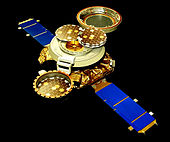
Kepler is a space observatory launched by NASA to discover Earth-like planets orbiting other stars.[26] The spacecraft, named in honor of the 17th-century German astronomer Johannes Kepler,[27] was launched in March 2009.[28]
Stardust is a 300-kilogram robotic space probe launched by NASA on February 7, 1999 to study the asteroid 5535 Annefrank and collect samples from the coma of comet Wild 2. The primary mission was completed January 15, 2006, when the sample return capsule returned to Earth.[29] Operating for 25 years, 8 months and 30 days, Stardust intercepted comet Tempel 1 on February 15, 2011, a small Solar System body previously visited by Deep Impact on July 4, 2005. It is the first sample return mission to collect cosmic dust and return the sample to Earth and the first to acquire images of a previously visited comet.
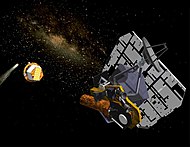
The Genesis spacecraft was a NASA sample return probe which collected a sample of solar wind and returned it to Earth for analysis. It was the first NASA sample return mission to return material since the Apollo Program, and the first to return material from beyond the orbit of the Moon.[30] Genesis was launched on August 8, 2001, and crash-landed in Utah on September 8, 2004, after a design flaw prevented the deployment of its drogue parachute. The crash contaminated many of the sample collectors, but although most were damaged, many of the collectors were successfully recovered.[31]
Deep Impact is a NASA space probe launched on January 12, 2005. It was designed to study the composition of the comet interior of 9P/Tempel, by releasing an impactor into the comet. At 5:52 UTC on July 4, 2005, the impactor successfully collided with the comet's nucleus. The impact excavated debris from the interior of the nucleus, allowing photographs of the impact crater. The photographs showed the comet to be more dusty and less icy than had been expected.
Clementine (1994)

Clementine (officially called the Deep Space Program Science Experiment (DSPSE)) was a joint space project between the Ballistic Missile Defense Organization (BMDO, previously the Strategic Defense Initiative Organization, or SDIO) and NASA. Launched on January 25, 1994, the objective of the mission was to test sensors and spacecraft components under extended exposure to the space environment and to make scientific observations of the Moon and the near-Earth asteroid 1620 Geographos. The Geographos observations were not made due to a malfunction in the spacecraft.
Mars Global Surveyor (1996)

The Mars Global Surveyor (MGS) was developed by NASA's Jet Propulsion Laboratory and launched November 1996. It began the United States' return to Mars after a 10-year absence. It completed its primary mission in January 2001 and was in its third extended mission phase when, on November 2, 2006, the spacecraft failed to respond to commands. In January 2007 NASA officially ended the mission.
The Surveyor spacecraft used a series of high-resolution cameras to explore the surface of Mars during its mission, returning more than 240,000 images spanning portions of 4.8 Martian years, from September 1997 to November 2006.[32] The surveyor's cameras utilized 3 instruments: a narrow angle camera that took (black-and-white) high resolution images (usually 1.5 to 12 m per pixel) red and blue wide angle pictures for context (240 m per pixel) and daily global imaging (7.5 kilometres (4.7 mi) per pixel).[33]
Cassini–Huygens (1997)
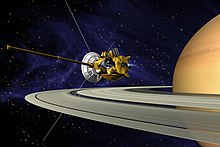
Cassini–Huygens is a joint NASA/ESA/ASI spacecraft mission studying the planet Saturn and its many natural satellites. It includes a Saturn orbiter and an atmospheric probe/lander for the moon Titan, although it has also returned data on a wide variety of other things including the Heliosphere, Jupiter, and relativity tests. The Titan probe, Huygens, entered and landed on Titan in 2005. Cassini is the fourth space probe to visit Saturn and the first to enter orbit, with its mission ongoing as of 2012.
It launched on October 15, 1997 on a Titan IVB/Centaur and entered into orbit around Saturn on July 1, 2004, after an interplanetary voyage which included flybys of Earth, Venus, and Jupiter. On December 25, 2004, Huygens separated from the orbiter at approximately 02:00 UTC. It reached Saturn's moon Titan on January 14, 2005, when it entered Titan's atmosphere and descended downward to the surface. It successfully returned data to Earth, using the orbiter as a relay. This was the first landing ever accomplished in the outer Solar System.
Sixteen European countries and the United States make up the team responsible for designing, building, flying and collecting data from the Cassini orbiter and Huygens probe. The mission is managed by NASA’s Jet Propulsion Laboratory in the United States, where the orbiter was assembled. Huygens was developed by the European Space Research and Technology Centre, whose prime contractor was Alcatel of France. Equipment and instruments for the probe were supplied by many countries.
New Millennium Program (1998–2006)
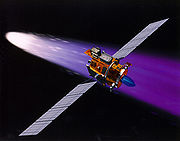
New Millennium Program (NMP) is a NASA project with focus on engineering validation of new technologies for space applications. Funding for the program was eliminated from the FY2009 budget by the 110th United States Congress, effectively leading to its cancellation.[34] The spacecraft in the New Millennium Program were originally named "Deep Space" (for missions demonstrating technology for planetary missions) and "Earth Observing" (for missions demonstrating technology for Earth orbiting missions). With a refocussing of the program in 2000, the Deep Space series was renamed "Space Technology".
Deep Space 1 (DS1) is a spacecraft dedicated to testing a payload of advanced, high risk technologies. Launched on October 24, 1998, the Deep Space mission carried out a flyby of asteroid 9969 Braille, which was selected as the mission's science target. Its mission was extended twice to include an encounter with Comet Borrelly and further engineering testing. Problems during its initial stages and with its star tracker led to repeated changes in mission configuration. While the flyby of the asteroid was a partial success, the encounter with the comet retrieved valuable information. Three of twelve technologies on board had to work within a few minutes of separation from the carrier rocket for the mission to continue.
The Deep Space series was continued by the Deep Space 2 probes, which were launched in January 1999 on Mars Polar Lander and were intended to strike the surface of Mars. Deep Space 1 was the first spacecraft to use Ion powered rocketry, in contrast to the traditional chemical powered rockets.
Gravity Recovery and Climate Experiment (2002)

The Gravity Recovery And Climate Experiment (GRACE), a joint mission of NASA and the German Aerospace Center, has been making detailed measurements of Earth's gravity field since its launch in March 2002. The satellites were launched from Plesetsk Cosmodrome, Russia on a Rockot (SS-19 + Breeze upper stage) launch vehicle. By measuring gravity, GRACE shows how mass is distributed around the planet and how it varies over time. Data from the GRACE satellites is an important tool for studying Earth's ocean, geology, and climate.
GRACE is a collaborative endeavor involving the Center for Space Research at the University of Texas, Austin; NASA's Jet Propulsion Laboratory, Pasadena, Calif.; the German Space Agency and Germany's National Research Center for Geosciences, Potsdam.[35] The Jet Propulsion Laboratory is responsible for the overall mission management under the NASA ESSP program. The principal investigator is Dr. Byron Tapley of the University of Texas Center for Space Research, and the co-principal investigator is Dr. Christoph Reigber of the GeoForschungsZentrum (GFZ) Potsdam.[36]
Earth Observing System (1997–2011)
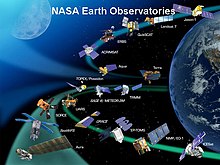
The Earth Observing System (EOS) is a program of NASA comprising a series of artificial satellite missions and scientific instruments in Earth orbit designed for long-term global observations of the land surface, biosphere, atmosphere, and oceans of the Earth. The satellite component of the program was launched in 1997. The program is centerpiece of NASA's Earth Science Enterprise (ESE).
Mission examples are: SeaWiFS (1997), Landsat 7 (1999), QuikSCAT (1999), Jason 1 (2001), GRACE (2002), Aqua (2002), Aura (2004) and Aquarius (2011)
Mars Exploration Rovers (2003)
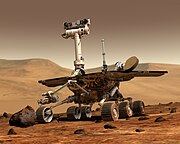
NASA's Mars Exploration Rover Mission (MER), is an ongoing robotic space mission involving two rovers exploring the planet Mars. The mission is managed for NASA by the Jet Propulsion Laboratory, which designed, built and is operating the rovers.
The mission began in 2003 with the sending of the two rovers—MER-A Spirit and MER-B Opportunity—to explore the Martian surface and geology. The mission's scientific objective is to search for and characterize a wide range of rocks and soils that hold clues to past water activity on Mars. The mission is part of NASA's Mars Exploration Program which includes three previous successful landers: the two Viking program landers in 1976 and Mars Pathfinder probe in 1997.[37]
The total cost of building, launching, landing and operating the rovers on the surface for the initial 90-Martian-day (sol) primary mission was US$820 million.[38] Since the rovers continued to function far beyond their initial 90 sol primary mission (six years to failure for Spirit, eight years and counting for Opportunity), they have each received multiple mission extensions.
MESSENGER (2004)
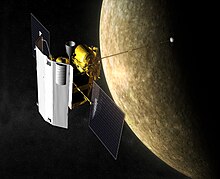
MESSENGER (an acronym of MErcury Surface, Space ENvironment, GEochemistry, and Ranging) is a robotic spacecraft orbiting the planet Mercury, the first spacecraft ever to do so.[39] The 485-kilogram (1,069 lb) spacecraft was launched aboard a Delta II rocket in August 2004 to study Mercury's chemical composition, geology, and magnetic field.
MESSENGER became the second mission after Mariner 10 to reach Mercury when it made a flyby in January 2008, followed by a second flyby in October 2008,[40] and a third flyby in September 2009.[41][42] Then MESSENGER entered orbit around Mercury on March 18, 2011.
The instruments carried by MESSENGER were used on that complex series of flybys – the spacecraft flew by Earth once, Venus twice, and Mercury itself three times, allowing it to decelerate relative to Mercury using minimal fuel. When MESSENGER entered orbit around Mercury on March 18, 2011, it then reactivated its science instruments on March 24, returning the first photo from Mercury orbit on March 29.
New Frontiers program (2006–2011)
The New Frontiers program is a series of space exploration missions being conducted by NASA with the purpose of researching several of the Sun's planets including Jupiter, Venus, and the dwarf planet Pluto. NASA is encouraging both domestic and international scientists to submit mission proposals for the project.
New Frontiers was built on the innovative approach used by the Discovery and Explorer Programs of principal investigator-led missions. It is designed for medium-class missions that cannot be accomplished within the cost and time constraints of Discovery, but are not as large as Flagship-class missions. There are currently two New Frontiers missions in progress, New Horizons which launched on January 19, 2006, and Juno which launched on August 5, 2011; a third New Frontiers mission, OSIRIS-REx, has been selected for launch in 2016.
Mars Scout Program (2007–2008)
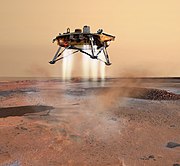
The Mars Scout Program was a NASA initiative to send a series of small, low-cost robotic missions to Mars, competitively selected from innovative proposals by the scientific community. The program had an array of missions destined to reach Mars, and study it at relatively low costs. Each Scout project was to cost less than US$485 million. The Phoenix lander and MAVEN orbiter were selected and developed before the program was retired in 2010.[43]
Phoenix was a lander originally intended for the canceled Mars Surveyor mission but adapted to the new mission. Phoenix was launched on August 4, 2007, and landed in the icy northern polar region of the planet on May 25, 2008. Phoenix was designed to search for environments suitable for microbial life on Mars, and to research the history of water there. The 90-day primary mission was successful and the overall mission was concluded on November 10, 2008, after engineers were unable to contact the craft. The lander last made a brief communication with Earth on November 2, 2008.
Dawn (2007)
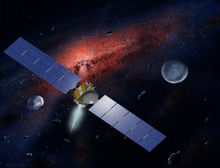
Dawn is a NASA spacecraft tasked with the exploration and study of the asteroid Vesta and the dwarf planet Ceres, the two largest members of the asteroid belt. The spacecraft was constructed with some European cooperation, with components contributed by partners in Germany, Italy, and the Netherlands. The Dawn mission is managed by NASA's Jet Propulsion Laboratory.
Dawn will be the first spacecraft to visit either Vesta or Ceres. It may furthermore be the first spacecraft to orbit two separate extraterrestrial bodies, using ion thrusters to travel between its targets. Previous multi-target missions using conventional drives, such as the Voyager program, were restricted to flybys.[44]
Launched on September 27, 2007, Dawn entered orbit around Vesta on July 16, 2011, and explored it until August 26, 2012.[45] Thereafter, the spacecraft headed to Ceres, which it reached in February 2015.[46] Dawn is NASA’s first purely exploratory mission to use ion propulsion.
Lunar Reconnaissance Orbiter (2009)

The Lunar Reconnaissance Orbiter (LRO) is a NASA robotic spacecraft currently orbiting the Moon on a low 50 km polar mapping orbit.[47] The LRO mission is a precursor to future manned missions to the Moon by NASA. To this end a detailed mapping program will identify safe landing sites, locate potential resources on the Moon, characterize the radiation environment, and demonstrate new technology.[48][49]
The probe will make a 3-D map of the Moon's surface and has provided some of the first images of Apollo equipment left on the Moon.[50][51] The first images from LRO were published on July 2, 2009, showing a region in the lunar highlands south of Mare Nubium (Sea of Clouds).[52]
Launched on June 18, 2009,[53] in conjunction with the Lunar Crater Observation and Sensing Satellite (LCROSS), as the vanguard of NASA's Lunar Precursor Robotic Program,[54] this is the first United States mission to the Moon in over ten years.[55] LRO and LCROSS are the first missions launched as part of the United States's Vision for Space Exploration program.
Mars Science Laboratory (2011)

Mars Science Laboratory (MSL) is a NASA mission to land and operate a rover named "Curiosity" on the surface of Mars.[56][57] It was launched November 26, 2011[58][59][60] and landed successfully on August 6, 2012 on the plains of Aeolis Palus in Gale Crater near Aeolis Mons (formerly "Mount Sharp").[61][62][63][64][65][66][67][68] On Mars it will help assess Mars' habitability. It can chemically analyze samples by scooping up soil and drill rocks using a laser and sensor system.[69]
The "Curiosity" rover is about five times larger than the "Spirit" or "Opportunity" Mars Exploration Rovers[70] and carries more than ten times the mass of scientific instruments. MSL was launched by an Atlas V 541 rocket and is designed to explore for at least 687 Earth days (1 Martian year) over a range of 5–20 km (3–12 miles).[69]
See also
References
- ^ NASA history
- ^ Clayton Koppes, "JPL and the American Space Program," (New Haven: Yale University Press, 1982); Erik M. Conway, "From Rockets to Spacecraft: Making JPL a Place for Planetary Science," Engineering and Science, vol. 30, nr. 4, pp. 2–10.
- ^ "Echo 1, 1A, 2 Quicklook". Mission and Spacecraft Library. NASA. Retrieved February 6, 2010.
- ^ Astronautix.com, Echo
- ^ "Echo 1". NASA. Retrieved July 13, 2010.
- ^ Cortright Oral History (p25)
- ^ Dick, Steven J. "NASA's First 50 Years: Historical Perspectives". NASA History. NASA Technical Reports Server. p. 12. Retrieved September 21, 2011.
- ^ a b c Chapter 6, NASA Experimental Communications Satellites, 1958–1995. Retrieved October 23, 2011
- ^ Bowker, David E. and J. Kenrick Hughes, Lunar Orbiter Photographic Atlas of the Moon [1], NASA SP-206 (1971).
- ^ "Whole Earth". Lunar Orbiter V. NASA. August 8, 1967. p. 352. Retrieved December 24, 2008.
Clearly visible on the left side of the globe is the eastern half of Africa and the entire Arabian peninsula.
- ^ Speed of the Voyager Space Probes
- ^ IRAS Explanatory Supplement II. Satellite Description IPAC IRAS archive
- ^ Lutz D. Schmadel – Dictionary of minor planet names (2003) – Page 315 (Google Books)
- ^ "NASA's Great Observatories". NASA. Retrieved April 26, 2008.
- ^ Dunar, A. J.; S. P. Waring (1999). Power to Explore—History of Marshall Space Flight Center 1960–1990. U.S. Government Printing Office. ISBN 0-16-058992-4. Chapter 12, "The Hubble Space Telescope" (PDF). (260 KB)
- ^ a b "Light goes out on solar mission". BBC News. British Broadcasting Company. June 26, 2009. Retrieved June 26, 2009.
- ^ ESA Portal – Sun to set on Ulysses solar mission on 1 July
- ^ ESA Portal – Ulysses hanging on valiantly
- ^ Solar wind blows at 50-year low 2008-09-24, Jonathan Amos, BBC News Online. Retrieved 2008-09-28
- ^ "Ulysses: 12 extra months of valuable science". European Space Agency. June 30, 2009. Retrieved July 1, 2009.
- ^ The odyssey concludes ...
- ^ Robert Garner (September 22, 2011). "Update No. 10". UARS. NASA. Retrieved September 22, 2011.
- ^ "UARS update no 15". NASA. Retrieved September 24, 2011.
- ^ N. POTTER and G. SUNSERI – Space Junk: NASA Says Satellite to Re-Enter Friday Afternoon; America Safe From Debris (2011) – ABC News
- ^ "One Way or Another, Space Agency Will Hitch a Ride to Mars". Washington Post. November 13, 1993.
- ^ Koch, David; Gould, Alan (March 2009). "Kepler Mission". NASA. Retrieved March 14, 2009.
- ^ DeVore, Edna (June 9, 2008). "Closing in on Extrasolar Earths". SPACE.com. Retrieved March 14, 2009.
- ^ NASA Staff. "Kepler Launch". NASA. Retrieved September 18, 2009.
- ^ "NASA Spacecraft Returns With Comet Samples After 2.9 Bln Miles". Bloomberg. Retrieved March 4, 2008.
- ^ The NASA Stardust mission launched two years before Genesis, but did not return to Earth until two years after Genesis's return.
- ^ "Solar Wind Curation at JSC". NASA.
- ^ "Space Cameras, Operations, and Science". Malin Space Science Systems. Retrieved August 13, 2010.
- ^ Malin, M. et al. Mars Global Surveyor Mars Orbiter Camera in the Extended Mission: The MOC Toolkit, 35th Lunar and Planetary Science Conference, March 15–19, 2004, League City, Texas, abstract no.1189
- ^ David Shiga (February 5, 2008). "NASA calls for ambitious outer solar system mission". New Scientist. Retrieved April 16, 2009.
- ^ "Grace Space Twins Set to Team Up to Track Earth's Water and Gravity". NASA/JPL.
- ^ "Mission Overview". University of Texas. November 19, 2008. Retrieved July 30, 2009.
- ^ "Mars Exploration Rover Mission Overview". NASA.
- ^ "NASA extends Mars rovers' mission". MSNBC. October 16, 2007. Retrieved April 5, 2009.
- ^ "NASA Spacecraft Circling Mercury". New York Times. March 17, 2011. Retrieved July 9, 2013.
- ^ "Countdown to MESSENGER's Closest Approach with Mercury" (Press release). Johns Hopkins University. January 14, 2008. Retrieved May 1, 2009.
- ^ "Critical Deep-Space Maneuver Targets MESSENGER for Its Second Mercury Encounter" (Press release). Johns Hopkins University. March 19, 2008. Retrieved April 20, 2010.
- ^ "Deep-Space Maneuver Positions MESSENGER for Third Mercury Encounter" (Press release). Johns Hopkins University. December 4, 2008. Retrieved April 20, 2010.
- ^ NASA's Scout Program Discontinued.
- ^ Rayman, Marc; Fraschetti; Raymond; Russell (April 5, 2006). "Dawn: A mission in development for exploration of main belt asteroids Vesta and Ceres" (PDF). Acta Astronautica. 58 (11): 605–616. Bibcode:2006AcAau..58..605R. doi:10.1016/j.actaastro.2006.01.014. Retrieved April 14, 2011.
- ^ "Dawn Gets Extra Time to Explore Vesta". NASA. April 18, 2012. Retrieved April 24, 2012.
- ^ "DAWN – A Journey to the Beginning of the Solar System". Dawn Mission Timeline. Jet Propulsion Laboratory. Retrieved March 18, 2012.
- ^ Where is LRO right now?
- ^ LRO Mission Overview, retrieved October 3, 2009
- ^ "Mission design and operation considerations for NASA's Lunar Reconnaissance Orbiter" (PDF). Goddard Space Flight Center. Retrieved February 10, 2008.
- ^ Koczor, Ron (July 11, 2005). "Abandoned Spaceships". NASA. Retrieved August 5, 2009.
- ^ Garner, Robert (July 17, 2009). "LROC images of Apollo sites". NASA. Retrieved August 5, 2009.
- ^ Garner, Robert (July 2, 2009). "LRO's First Moon Images". NASA. Retrieved August 5, 2009.
- ^ "Lunar Reconnaissance Orbiter Launch". Goddard Space Flight Center. Retrieved March 22, 2008.
- ^ Mitchell, Brian. "Lunar Precursor Robotic Program: Overview & History". NASA. Retrieved August 5, 2009.
- ^ Dunn, Marcia (June 18, 2009). "NASA launches unmanned Moon shot, first in decade". ABC News. Associated Press. Archived from the original on June 20, 2009. Retrieved August 5, 2009.
{{cite news}}: Unknown parameter|deadurl=ignored (|url-status=suggested) (help) - ^ "Name NASA's Next Mars Rover". NASA/JPL. May 27, 2009. Retrieved May 27, 2009.
- ^ "NASA Selects Student's Entry as New Mars Rover Name". NASA/JPL. May 27, 2009. Retrieved May 27, 2009.
- ^ NASA – Mars Science Laboratory, the Next Mars Rover
- ^ Guy Webster. "Geometry Drives Selection Date for 2011 Mars Launch". NASA/JPL-Caltech. Retrieved September 22, 2011.
- ^ Allard Beutel (November 19, 2011). "NASA's Mars Science Laboratory Launch Rescheduled for Nov. 26". NASA. Retrieved November 21, 2011.
- ^ NASA Staff (August 6, 2012). "Curiosity's Daily Update: Curiosity Safely on Mars! Health Checks Begin". NASA. Retrieved August 12, 2012.
- ^ NASA Staff (March 27, 2012). "'Mount Sharp' on Mars Compared to Three Big Mountains on Earth". NASA. Retrieved March 31, 2012.
- ^ Agle, D. C. (March 28, 2012). "'Mount Sharp' On Mars Links Geology's Past and Future". NASA. Retrieved March 31, 2012.
- ^ Staff (March 29, 2012). "NASA's New Mars Rover Will Explore Towering 'Mount Sharp'". Space.com. Retrieved March 30, 2012.
- ^ USGS (May 16, 2012). "Three New Names Approved for Features on Mars". USGS. Retrieved May 20, 2012.
- ^ Webster, Guy; Brown, Dwayne (July 22, 2011). "NASA's Next Mars Rover to Land At Gale Crater". NASA JPL. Retrieved July 22, 2011.
- ^ Chow, Dennis (July 22, 2011). "NASA's Next Mars Rover to Land at Huge Gale Crater". Space.com. Retrieved July 22, 2011.
- ^ Amos, Jonathan (July 22, 2011). "Mars rover aims for deep crater". BBC News. Retrieved July 22, 2011.
- ^ a b "Mars Science Laboratory: Mission". NASA/JPL. Retrieved March 12, 2010.
- ^ Watson, Traci (April 14, 2008). "Troubles parallel ambitions in NASA Mars project". USA Today. Retrieved May 27, 2009.


